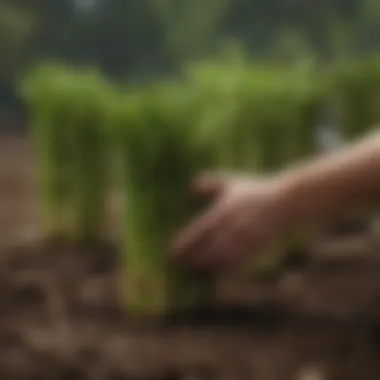Timing Your Asparagus Seed Planting for Success


Intro
Asparagus, with its distinct flavor and nutritional benefits, has been a favored vegetable for many gardeners. However, the journey to a bountiful asparagus harvest begins long before the first shoots push through the soil. Understanding when to plant asparagus seeds is pivotal for success. It's not merely a matter of grabbing a pack of seeds and tossing them into the ground; a blend of timing, climate, and soil conditions beckons careful consideration.
Whether you are a seasoned gardener or just dipping your toes into the world of gardening, timing can significantly influence your crop yield. An asparagus plant is known to have a long lifespan, sometimes lasting for up to fifteen years or more. Therefore, planning your planting period is critical to establish robust plants that deliver harvest year after year.
Let's take a journey through the essential considerations that will guide you in choosing the optimal moment for planting your asparagus seeds. From understanding the local climate to employing proper soil prep, we aim to create a comprehensive plan that guides you every step of the way.
Understanding Climatic Conditions
Asparagus thrives best in certain climate conditions, making them vital to consider when planting. Here’s a breakdown of the crucial elements:
- Temperature: Asparagus seeds require a soil temperature of at least 70°F (21°C) for optimal germination. This usually means waiting until late spring for most regions.
- Frost Warnings: It is essential to avoid planting during late frost periods. Check your local frost dates and ensure you are safe from surprise cold snaps.
- Rainfall and Humidity: Sufficient moisture levels can lead to vigorous growth. However, excessive rainfall can lead to over-saturation, causing seeds to rot.
"Timing in planting is a balance of nature's rhythm and your preparation."
Being aware of your regional climate can help you fine-tune your planting schedule. Southern areas might have a longer growing season compared to northern locales. For instance, those in the Midwest should be mindful of their harsher winters, while warmer places like Florida can kick off growing earlier in the year.
Soil Preparation: Laying the Groundwork
Before you can even think about planting, the right soil prep is crucial. Asparagus likes well-drained, sandy loam soil enriched with organic matter. Here are key steps for preparing your soil:
- Test Soil pH: Asparagus prefers a soil pH between 7.0 and 8.0. You might need to adjust with lime or sulfur based on your test.
- Clear Weeds and Debris: A clean slate is essential for healthy growth. Pull any weeds and debris before planting.
- Add Organic Material: Incorporating compost or well-rotted manure can significantly enhance soil fertility. This helps the soil retain moisture without becoming overly compacted.
Taking the time to prepare the soil wisely can make a world of difference when the asparagus starts to grow.
Seed Selection: What Will You Plant?
Choosing the right seeds is another step to guarantee solid growth. You might have encountered different varieties like Mary Washington or Purple Passion. Each one comes with its unique flavor and resilience. Here’s what you should keep in mind:
- Disease Resistance: Some varieties are more resistant to pests and diseases than others.
- Harvest Time: Early or late maturing varieties can affect when you'll start to see your first harvest.
So, think about not just what you like to eat, but also what your local climate will best support.
Closure
Understanding Asparagus Growth
Understanding the growth of asparagus is foundational for anyone looking to cultivate this unique vegetable. Asparagus is not just a crop; it’s a long-term investment in your gardening efforts. Unlike many plants, it takes time and proper attention to establish itself. By grasping the intricacies of its growth cycle and perennial nature, gardeners can strategically plan their actions to optimize yield and health of the plants.
The life cycle of asparagus informs when and how to plant, providing critical insight into the timing and processes that maximize the chances of a fruitful harvest. Seasonal fluctuations, localized climate conditions, and soil quality play pivotal roles in asparagus growth, all of which are interlinked.
The Life Cycle of Asparagus
Asparagus has a distinct life cycle that spans several years. When you plant seedlings directly, you are initiating a journey that will require patience and dedication. The life cycle consists of several phases:
- Germination: Seeds typically take about 2-3 weeks to sprout, needing warm soil temperatures and moisture. The sowing process can set the stage for everything to follow.
- Vegetative Growth: After sprouting, young plants focus on developing strong root systems and shoots. This phase lasts about 2-3 years. During this time, adequate care is crucial.
- Maturity: After the establishment period, which can be 2-3 years, asparagus enters its productive phase, often peaking around its 4th or 5th year. This is when gardeners start to see the thriving green stalks.
- Dormancy: Eventually in autumn, the plants go through a rest period where the tops die back, allowing resources to return to the roots for robust re-growth in spring.
"A well-rooted asparagus plant has the potential to produce stalks for decades if tended to properly."


This cycle means that initial sowing often isn't about immediate gratification; it's about laying the groundwork for future harvests. Understanding this life cycle is essential, as it informs decisions such as fertilization, watering, and even harvest timing, all critical factors in growing a sustainable asparagus crop.
Perennial Nature of Asparagus
Asparagus is classified as a perennial, which means it survives more than two growing seasons. This allows it to go beyond the ordinary one-season crops often found in vegetable gardens. The perennial nature has various implications for gardeners:
- Continuous Harvest: Once established, asparagus can yield for 15 years or more. Each spring brings new growth with lower annual input compared to annual plants.
- Soil Health: Perennials contribute to more stable soil health over time. Their roots create a network that contributes to soil structure and nutrient retention, making it less likely to need heavy interventions through fertilizers.
- Investment Return: The upfront labor and resources put into establishing asparagus ultimately pay off as these plants come back stronger year after year, reducing the need for replanting.
Climatic Conditions for Planting
When it comes to successfully growing asparagus, understanding climatic conditions proves essential. The subtleties of weather patterns, temperature, and seasonal shifts can dictate not just how well your asparagus thrives, but also how bountiful your harvest will be. Nurturing these green stalks requires patience and attention to detail, and knowing the best conditions to plant assures you're setting the stage for delightful spring feasts down the line.
Optimal Temperature Ranges
Asparagus seeds relish warmth, but too much heat can send them packing. Optimal germination takes place when soil temperatures hang around 70°F to 85°F (21°C to 29°C). Below this range, particularly in the chilly early spring, seeds may struggle, while excess heat in the summer can stress younger plants. Think of it as finding that sweet spot, akin to Goldilocks and her porridge—not too hot, not too cold, but just right. In most regions, this means getting your seeds in the ground in early to late spring in typical zones, while areas with consistently warm soil can push the planting window towards late winter.
Frost and Asparagus: Timing Matters
Frost is the arch-nemesis of young asparagus plants. Cold snaps can snap their spirits, leading to damages that can stunt growth or, worse, kill tender seedlings. To ward off this hazard, pay attention to local frost dates. Many seasoned gardeners recommend planting after your area's last frost date. This basically translates to keeping an eye on weather forecasts and perhaps even doing a little dance of joy when winter loosens its grip. If you're eager to get a jump start, consider starting seeds indoors a few weeks before the last frost, then transferring them outdoors when conditions are cozy and safe.
Successful asparagus cultivation hinges on timing—plant when nature gives the green light.
Regional Climate Variations
Not all climates are created equal when it comes to asparagus cultivation. In northern regions, you’ll often find gardeners starting their seeds in late spring when frosty threats have passed. Conversely, homeowners in the southern regions can benefit from planting much earlier, often as soon as winter bids farewell. The temperate areas fall somewhere in the middle, with planting windows opening up as soon as the soil starts to warm up.
Additionally, factors such as humidity and rainfall can also play significant roles. For instance, in hot, dry climates, ensuring that your soil retains moisture becomes vital, while in regions where rainfall is frequent, drainage should become a priority to prevent plants from drowning. Understanding your specific regional climate can mean the difference between a mediocre crop and a towering crop.
Soil Preparation Techniques
Soil preparation is a critical cornerstone for successfully planting and growing asparagus. The right soil conditions can make all the difference in not just establishing seedlings, but also promoting robust growth over the years. If you skimp on this step, you might end up with sparce or weak asparagus plants. Essentially, preparing your soil is akin to setting a solid foundation for a house. Without it, you'd be building on quicksand—all your efforts could go to waste.
Soil Type Preferences
Asparagus thrives best in sandy loam soils that offer good drainage. Such soils allow moisture and nutrients to permeate easily while preventing water from pooling. The ideal pH for asparagus ranges between 7.0 and 7.8. So, if your soil is too acidic or alkaline, consider testing it before planting.
Some gardeners might find heavy clay soils or compacted ground. This type of soil can be problematic. It often leads to waterlogging, resulting in root rot. If your garden boasts such challenging conditions, consider integrating organic matter like compost or peat moss to improve drainage and soil aeration.
"Healthy soil is the heart of a thriving garden, nurturing every seed and root that graces it."
Another method can involve the use of raised garden beds. These frames allow you to control soil quality, pH, and drainage—far easier than digging deep into the ground, which can be back-breaking work. If you use raised beds, mix your native soil with high-quality topsoil to ensure your asparagus plants have the nutrients they need.
Amending Soil for Healthier Growth
Once you've identified your soil type, it’s time to amend it. There are several ways to enhance your soil quality:
- Adding Organic Matter: This includes compost, well-rotted manure, or leaf mold. Such amendments improve soil structure, making it easier for roots to spread out. Organic matter also retains moisture, so even during a dry spell, your asparagus can have access to water.
- Incorporating Nutrients: A balanced fertilizer may be necessary, particularly one rich in potassium and phosphorus. These nutrients run the show when it comes to asparagus health. They encourage deeper root systems and improve yield in the long run.
- Testing Soil: Consider utilizing a soil test kit. Knowing your soil’s nutrient levels can guide your amendments. Different kits can tell you about pH levels and nutrient content, allowing you to make informed decisions.
In the end, the aim is to create an ecosystem in your soil where nutrients are readily available, pathogens are kept at bay, and moisture is neither too plentiful nor too scarce. With these preparations, enthusiasm shouldn’t wane. Instead, you should feel well-equipped to ensure your asparagus thrives for the long haul.


Selecting Asparagus Seeds
Choosing the right seeds plays a crucial role in the success of growing asparagus. It's not merely about selecting seeds; it's about making informed decisions that align with your gardening ambitions. When it comes to asparagus cultivation, the seed variety you choose can significantly influence the growth rate, disease resistance, and overall vitality of your plants.
Knowing the right varieties to grow for your region and understanding their unique characteristics can make or break your crop. Different seeds offer varying yields and can adapt to diverse climatic conditions, which is essential for long-term productivity. The process of selecting asparagus seeds is not just a mundane step in gardening; it is foundational for a thriving asparagus bed that can last for years.
Understanding Seed Varieties
Asparagus seeds come in several varieties, each tailored for specific growing conditions and purposes. Here are some commonly sought varieties:
- Jersey Knight: Known for its superior disease resistance and high yield, it’s well-suited for a range of climates.
- Mary Washington: A classic, this variety is known for its tender spears and good flavor. It's an older variety but remains popular among home gardeners.
- Purple Passion: With its luscious purple hue, this variety can draw attention and is noted for its sweet flavor. However, it’s not as hardy as green types.
- Viking: Offering a robust profile, Viking is appreciated for its high tolerance to pests and diseases, making it a reliable option.
Each of these types has distinct characteristics which can also determine factors like growth speed and flavor. Selecting a variety based on personal preference, local climate, and soil conditions can greatly enhance your chances of having a bountiful harvest.
Quality Seed Sourcing
Ensuring high-quality seeds is equally vital. The market is flooded with seed options ranging from reputable brands to unknown sources. Before making a purchase, consider the following:
- Reputable Suppliers: Stick to well-known seed companies or local suppliers who have a track record for quality.
- Certification Labels: Look for certified seed labels which often indicate better germination rates and disease resistance.
- Reviews and Testimonials: Seek out reviews from other gardeners who have purchased seeds from various suppliers. Websites like Reddit can provide real-world experiences and recommendations.
- Sustainable Practices: More and more gardeners are looking for seeds from sustainable sources. Consider suppliers that focus on organic practices.
Ultimately, the seeds are your foundation. A poor seed choice can lead to lackluster growth or, worse, total crop failure. By investing in quality seeds from trusted sources, you're setting the stage for a fruitful asparagus garden which might provide yields for years to come.
Timing the Planting Process
Understanding the timing for planting asparagus seeds is essential for fostering healthy growth and maximizing yields. As a perennial plant, asparagus has specific needs that vary according to climate, soil, and seedling conditions. Getting the timing right not only enhances plant vigor but also ensures the successful establishment of your asparagus bed, which can produce for many years. The right timing helps you avoid cold snaps, promotes robust growth, and sets the stage for successful harvest seasons.
When to Plant in Different Regions
Cool Climate Planting Schedules
In regions with cool climates, the timing of planting asparagus is crucial. Typically, these areas experience a shorter growing season. For best results, planting begins as early as two to four weeks before the last expected frost. This approach allows seeds to germinate in the cool spring weather before warmer temperatures arrive.
One significant characteristic of this planting schedule is that it enables the roots to develop deep into the soil before the heat of summer kicks in. This depth contributes to healthier plants and larger spears. However, one must not ignore the potential risk of late frosts damaging tender young shoots. Thus, protective measures might be necessary until the danger has passed, which can involve using row covers or other protective barriers.
Temperate Climate Considerations
For gardeners in temperate zones, things are a bit different. Here, asparagus can be planted in late spring after the last frost date has passed, allowing the plants to thrive in warmer soil where germination happens faster. In temperate climates, consistency in moisture levels is often more reliable, which further supports healthy growth.
The key aspect here is choosing a time that coincides with the natural warmth of the soil. When soil temperatures reach around 60°F (15°C), it's a good indication that conditions are ripe for planting. A unique feature of this timing is that it enables gardeners to start their asparagus crop alongside other vegetables in the garden, creating a diverse planting environment. This approach may lead to advantages like better pest management and improved soil health, given the increased biodiversity.
Tropical Zones and Asparagus Planting
In tropical climates, the approach to planting asparagus takes a completely different direction due to more stable final temperatures year-round. While the summer months can be quite hot, the critical factor is to plant during the rainy season when moisture is more abundant. Successful planting typically occurs in late spring to early summer, but careful observation of local rainfall patterns is paramount.
An important characteristic of asparagus planting in these areas is the ability to grow year-round, although extreme heat and excess humidity can be detrimental. This leads to concerns with pests and diseases like root rot. Therefore, spacing andsoil drainage become essential considerations.
"Planting asparagus in tropical zones opens the door to potential year-round harvests; however, grower must be cautious of the environmental variables that can impact plant health."
Seedling vs. Seed Planting


When discussing the optimal timing, one should also consider whether to start from seeds or seedlings. Planting seeds offers a more economical option but requires careful timing to ensure they are sown under appropriate conditions—like temperature and moisture levels. Conversely, seedling planting occurs with a more straightforward approach as these young plants have already begun their growth trajectory.
Choosing between seeds and seedlings can dramatically affect your planting timeline. Seeds often take longer to grow compared to seedlings, which can mean a wait for the first harvest. However, opting for seeds can offer a wider variety of plants that might not be available as seedlings.
Post-planting Care
After planting asparagus seeds, the care that comes next is crucial. This phase can really make or break your asparagus crop. You’ve invested time and effort into planting; now it’s time to nurture those young plants to ensure they flourish. Failing to provide adequate post-planting care may lead to stunted growth or even complete crop failure, so understanding how to look after them is paramount.
Watering Regimens
Watering is king, or at least it should be when it comes to young asparagus plants. Right after you’ve placed the seeds or seedlings in the ground, they need moisture to kickstart their growth. Here are some general guidelines on watering regimens:
- Consistent Moisture: Initially, keep the soil consistently moist but not soggy. The seeds should never dry out completely, yet you want to avoid waterlogging.
- Deep Watering: As the plants establish, shift to deeper watering sessions spaced further apart. This encourages deep root growth — a crucial factor for a healthy asparagus crop.
- Signs of Thirst: Watch for signs that the plants are thirsty. Yellowing leaves can be a telltale sign that they need some hydration.
Fertilizing Techniques
Now, onto fertilizers. Asparagus is a heavy feeder, meaning it needs a fair amount of nutrients to thrive. Here’s how to effectively fertilize your asparagus:
- Soil Testing First: Before tossing in any fertilizers, consider doing a soil test to understand what nutrients you have. You might find that you need to adjust your feeding plan based on what the soil is lacking.
- Organic Options: Instead of jumping straight to chemical fertilizers, consider organic ones like compost or aged manure. They not only provide nutrients but also improve soil structure.
- Timing is Everything: Apply fertilizer in early spring, just as the plants poke through the soil. This timing helps them take advantage of the nutrients right when they need them most. Repeat the process after the harvest, giving a boost for the next growth cycle.
Weed and Pest Management
Weeds and pests can be the bane of your gardening existence. It’s important to tackle these issues early on. Here are some effective strategies for managing these threats:
- Mulching: Adding a layer of mulch around your plants can suppress weeds by blocking their sunlight, while retaining moisture in the soil at the same time.
- Regular Inspections: Keep an eye on your asparagus beds. Inspect plants weekly for any signs of pests or diseases. Early identification can make a huge difference in how effectively you can tackle the issue.
- Natural Predators: Encourage beneficial insects in your garden. Ladybugs and lacewings are natural pest controllers; they will help keep harmful bugs at bay.
"An ounce of prevention is worth a pound of cure."
In gardening, especially when it comes to post-planting care, recognizing and addressing issues before they spiral out of control is key. Getting a handle on watering, fertilizing, and managing weeds and pests lays the groundwork for a successful asparagus harvest.
Long-term Asparagus Cultivation
Growing asparagus is not just a seasonal endeavor; it is a long-term commitment that rewards gardeners over several years. Understanding long-term asparagus cultivation is crucial for any enthusiast who wishes to enjoy tender spears season after season. Invest both time and effort upfront, and you’ll reap bountiful rewards with minimal upkeep over the years.
One of the key elements to consider is the harvest cycle. Asparagus is unique among vegetables; once established, it can produce for 15 years or more. The first couple of years are primarily focused on growth rather than harvesting. Gardeners typically avoid significant harvesting until the third year. This patience pays off, as plants become more robust, yielding larger and more frequent harvests. It’s essential to let young plants develop strong roots before extensive harvesting, as this fosters healthy growth in future seasons.
Understanding Harvest Cycles
The harvest cycle of asparagus requires strategic thinking and a thorough understanding of the species' biology. During the first year, you may see only a few shoots emerge—these should be left to grow into fronds. They are crucial for photosynthesis, which helps the plant store energy for the next season. In the second year, some spears can be harvested, but it’s advisable to limit this to a couple of weeks.
By the third year, the plants mature. You can harvest asparagus for around 6-8 weeks, typically beginning in early spring, when the soil temperature consistently warms up. Keeping track of local climate conditions can help you determine the best harvesting time for your region. Here’s a general outline:
- Year 1: Establishment, minimal harvesting
- Year 2: Limited harvest, focus on plant health
- Year 3: Significant harvest, 6-8 weeks duration
This cycle not only requires attention to plant age but also to other factors like weather and soil condition. Patience is the name of the game, and becoming familiar with the growth patterns can ensure that your asparagus beds yield their best.
Maintaining Asparagus Beds
Maintaining asparagus beds over the years is just as vital as the initial planting. These beds can last many years, but they do require regular care. One substantial factor in maintenance is weed control. Weeds compete for resources and can choke young asparagus plants. A mulch layer can serve this purpose well, keeping weeds at bay while retaining moisture in the soil. Organic mulches, like straw or shredded leaves, can be beneficial.
Another essential aspect is fertilizing. Well-balanced fertilizer in early spring can provide the nutrients plants need to thrive. For optimal results, try using compost or well-rotted manure, ensuring a slow release of nutrients throughout the growing season. Follow a schedule, but also listen to your plants; discoloration can be a sign they need something more.
Lastly, can you forget about pest management? While asparagus generally fends off many common pests, asparagus beetles can wreak havoc if not managed carefully. Regular monitoring of plants helps catch any trouble early on.
Regular maintenance and observation can make the difference between an average asparagus crop and a stunning one!
In summary, the long-term cultivation of asparagus revolves around understanding growth patterns, maintaining beds, managing harvest cycles, and feeding the plants properly. Commit to these best practices, and you are likely to find that your asparagus will be the star of your garden for years to come.



